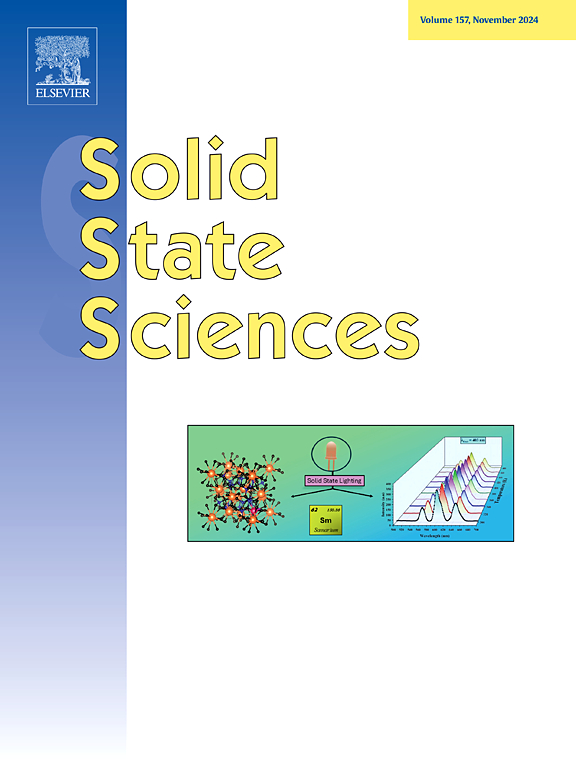Production of high capacity porous nickel borides via novel molten salt electrolysis
IF 3.4
3区 化学
Q2 CHEMISTRY, INORGANIC & NUCLEAR
引用次数: 0
Abstract
This work focused on producing Ni-boride powders via the novel boron diffusion method called CRTD-Bor (cathodic reduction and thermal diffusion-based boriding) and their electrochemical examinations. The nickel specimens with mesh geometry were borided through the whole cross-section at 1000 °C and 200 mA/cm2 for 2 h and held inside of the molten electrolyte for 1 h of phase homogenization. After the boriding treatment, the fully boron diffused specimens were ground via a ball mill and cold-pressed. The structural characterizations of the Ni-boride powders were carried out by using X-ray diffractometry (XRD), scanning electron microscopy (SEM). The results demonstrated that the powders were composed of NiB, Ni4B3, Ni2B, and Ni3B, where Ni4B3 was dominant. To examine the electrochemical behaviors of produced electrodes, cyclic voltammetry (CV) and galvanostatic charge-discharge (GCD) techniques were performed through the standard three-electrode system. The CV experiment was conducted within the potential range of 0–0.45 V, over 2000 cycles at 200 mV/s. While a 76 % increase in areal capacitance (Ca) was detected until the 1000th cycle, this value remained constant afterward. Ca was calculated as 1500 mF/cm2 at 10 mV/s. At different scan rate experiments, the b value was found as 0.65, representing the system was under mixed control, namely both capacitive and faradaic. The charge/discharge behavior was investigated via GCD at different current densities (0.1–0.01 A/cm2). According to data obtained from GCD, the energy and power density values were calculated as 57.5 mWh/cm2 and 3450 mW/cm2 at 0.01 A/cm2, respectively.

新型熔盐电解法制备高容量多孔硼化镍
本文主要研究了新型硼扩散方法CRTD-Bor(阴极还原和热扩散为基础的渗硼)制备硼化镍粉末及其电化学性能。在1000°C和200 mA/cm2的温度下,将具有网状结构的镍试样在整个横截面上进行渗硼2小时,并在熔融电解质中进行1小时的相均匀化。渗硼处理后,采用球磨机对渗硼充分的试样进行研磨和冷压处理。采用x射线衍射仪(XRD)、扫描电镜(SEM)对制备的硼化镍粉末进行了结构表征。结果表明,粉末主要由NiB、Ni4B3、Ni2B和Ni3B组成,以Ni4B3为主。为了研究制备的电极的电化学行为,通过标准的三电极系统进行了循环伏安法(CV)和恒流充放电(GCD)技术。CV实验在0-0.45 V的电位范围内,以200 mV/s的速度进行2000次循环。而面积电容(Ca)增加了76%,直到第1000个周期,该值保持不变。Ca在10 mV/s下计算为1500 mF/cm2。在不同扫描速率的实验中,b值为0.65,表明系统处于电容式和法拉第式混合控制下。通过GCD研究了不同电流密度(0.1 ~ 0.01 A/cm2)下的充放电行为。根据GCD获得的数据,在0.01 A/cm2时,计算出能量和功率密度值分别为57.5 mWh/cm2和3450 mW/cm2。
本文章由计算机程序翻译,如有差异,请以英文原文为准。
求助全文
约1分钟内获得全文
求助全文
来源期刊

Solid State Sciences
化学-无机化学与核化学
CiteScore
6.60
自引率
2.90%
发文量
214
审稿时长
27 days
期刊介绍:
Solid State Sciences is the journal for researchers from the broad solid state chemistry and physics community. It publishes key articles on all aspects of solid state synthesis, structure-property relationships, theory and functionalities, in relation with experiments.
Key topics for stand-alone papers and special issues:
-Novel ways of synthesis, inorganic functional materials, including porous and glassy materials, hybrid organic-inorganic compounds and nanomaterials
-Physical properties, emphasizing but not limited to the electrical, magnetical and optical features
-Materials related to information technology and energy and environmental sciences.
The journal publishes feature articles from experts in the field upon invitation.
Solid State Sciences - your gateway to energy-related materials.
 求助内容:
求助内容: 应助结果提醒方式:
应助结果提醒方式:


